Columbus’ Navigating Tools
Europeans learned how to use the compass that was invented in China. The Chinese inventions of paper and gunpowder were also useful to Europeans. Before the time of Columbus, European traders made long and tortuous overland journeys over thousands of miles to get to the Far East — China, India, Japan and Southeast Asia. Europeans grouped all these places into one region that they called the Indies.
What kinds of goods did people in Europe want to get from the Indies?
[Take suggestions.]
They wanted many riches: spices, gold, and silk.
DIGITAL EFFECT: Chris Columbus
Clear the dome of the cardinal points, the Polaris highlight, and the information displays while fading on the still image of Genoa Today.
VISUAL 13 (still): Genoa Today
[Fade on the still image of Genoa Today.]
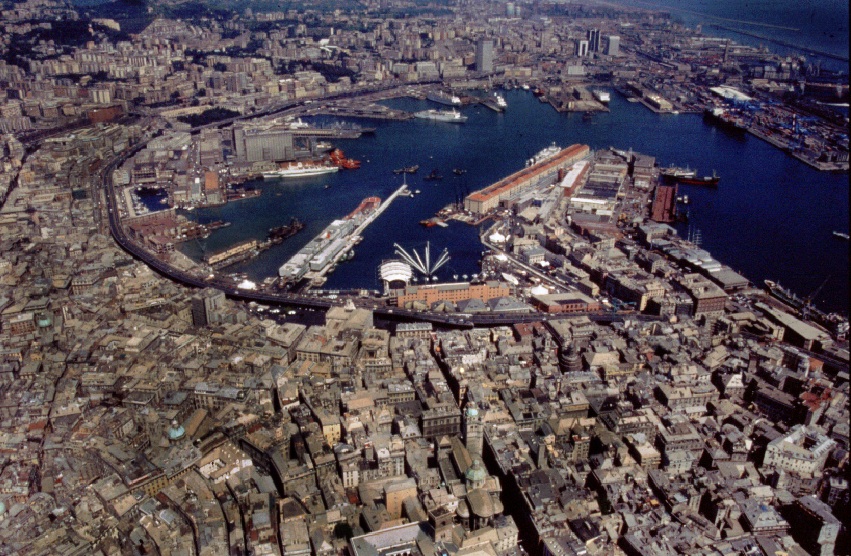
Columbus grew up in Genoa, Italy, which is still a thriving port city. Five hundred years ago, ships from Genoa and other European cities sailed throughout the Mediterranean Sea, as well as up and down the west coast of Africa. Nearly every ship’s cargo included slaves. In those days, people of many different cultures and races were captured and sold as slaves. Not everyone believed that it was right to enslave people, but nearly all merchants participated in the international slave trade because it made them very wealthy.
VISUAL 14 (still): Japanese Temple of Gold
[Fade on the still image of the Japanese Temple of Gold.]
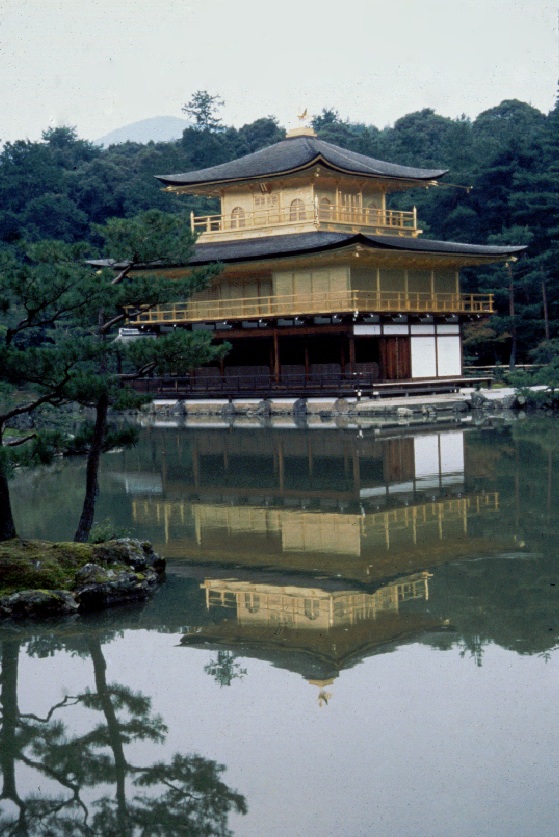
[Fade off both images of Genoa and the temple.]
As a merchant, Columbus knew of great wealth in the Indies. He may have heard about this temple, which is entirely covered with gold leaf. The temple is in the country Columbus called Cipangu, which we now know as Japan. The cost of silk and spices from the Indies was high, because of the difficult overland journey, and the goods were taxed heavily by the people who lived along the route. If Columbus could find a sea route to the Indies, he could avoid the taxes and sell his goods at a much greater profit. He could become the richest merchant of all!
VISUAL 15 (still): Columbus’ World Map Showing Routes from Portugal
In 1488, the Portuguese captain Bartholomew Dias made a voyage in which he rounded the southern tip of Africa and sailed along its eastern coast toward the Indies.

VISUAL 16 (still): Columbus’ World Map Showing His Plan
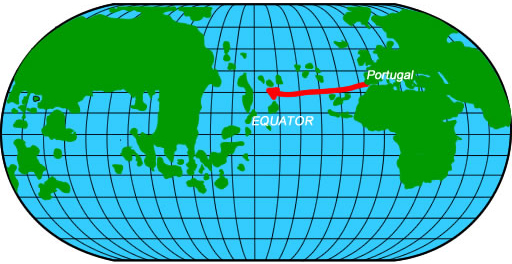
But Columbus had another plan. He wanted to sail west across the great Ocean Sea to reach the Indies.
[Fades off both map images.]
It is often said that Columbus wanted to prove the Earth was round.
VISUAL 17 (still): Land Rising as Ship Approaches
But Columbus was a sailor; and like all sailors of his time, he already knew the Earth was round. He knew because he had seen islands appear to rise from the ocean as he sailed toward them. On a flat Earth, this would not happen. All sailors knew that the Earth was round.

Optional
He had also seen the Sun and Moon in the sky, as you can see them.
What shape are the Moon and Sun? [Round.]
Many people reasoned that the Earth was also round because when you see an eclipse of the Moon, as we will see later, the shadow of the Earth on the Moon is always round. Only a “ball–shaped” Earth will always make a round shadow on the Moon during an eclipse.
Other evidence that the Earth is round was found by comparing the length of the shadow of a stick at noon in various locations many miles directly north or south of each other. The lengths of the shadows are different.
Columbus tried to convince the kings and queens of England, Portugal, and Italy to finance his journey, but failed many times. This is mainly due to the fact that his plan called for sailing west into relatively unfamiliar waters rather than along safer coastal routes.
Do you know who finally supported Columbus’ plan to sail west across the Ocean Sea?
[King Ferdinand and Queen Isabella of Spain.]
VISUAL 18 (still): Arguments at Salamanca
Before the King and Queen would give him money for ships, supplies, and a crew, Columbus first had to go to Spain’s best university, in Salamanca, to convince its professors that his plan was practical. We see Columbus at Salamanca in this image.
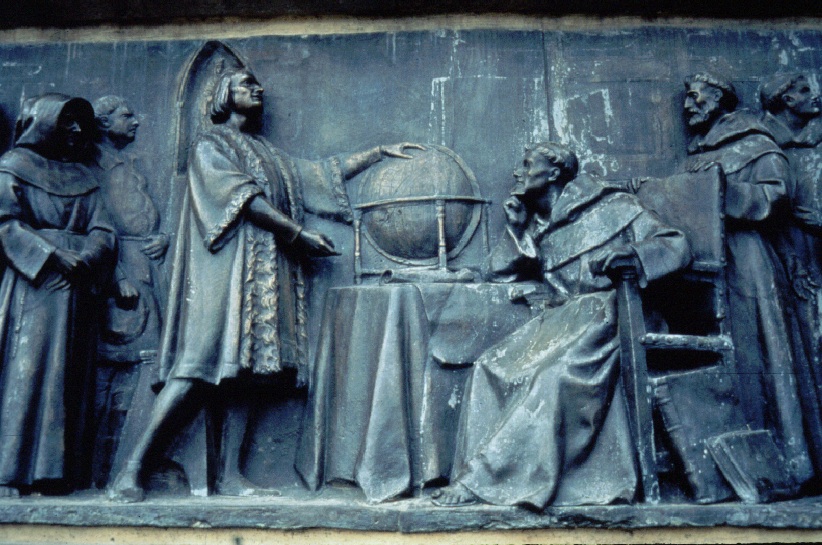
What shape is the model of the Earth is this image? [Round.]
You may have heard that Columbus proved that the Earth was round, but that is not what he did. In those days, all educated Europeans knew that the world was round. Columbus didn’t need to prove it. Scholars had known this for over 1,800 years. So what did Columbus argue about with the professors? Let’s look at some maps and see.
Distribute “Who ‘Discovered’ America?” handout, one to each student. If necessary, hand out pencils.
Fade off the land rising and Salamanca images.
VISUAL 19 (still): Columbus’ World Map
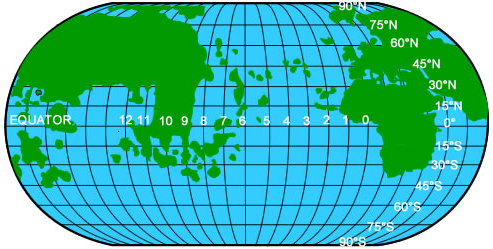
VISUAL 20 (still): Modern World Map
[Fade on the still image of the Modern World Map (also from the handout).]
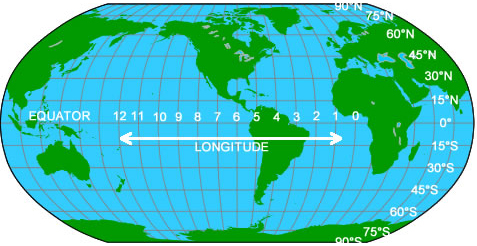
Please look at the side of the paper that says “Columbus’ World Map” at the top. What is the difference between “Columbus’ World Map” and the “Modern World Map”?
[Allow time for students look at the maps and discuss their observations. Accept several answers.]
The modern world map is larger. Columbus thought the Earth was only about 18,000 miles around, while professors at Salamanca argued that it was about 24,000 miles around: much closer to what geographers believe today. It was known that the trip from Europe to Asia by land was about 12,000 miles, so Columbus argued that most of the world was covered by land and “The Ocean Sea” was not very big. The professors argued that the Ocean Sea covered only about half of the world.
Using the time scale at the bottom of “Columbus’ World Map,” figure out how long it would take to cross the Ocean Sea on both maps. Who can tell me how long Columbus thought the voyage would take?
[About 1 month to the large island, which he thought was Japan.]
And, how long did the professors think the voyage would take?
[About 3 months, keeping in mind that they did not expect that the American continents intervened.]
VISUAL 21 (still): Ship Like Columbus’
[Fade off the map images, then fade on the still image of the Ship Like Columbus’.]
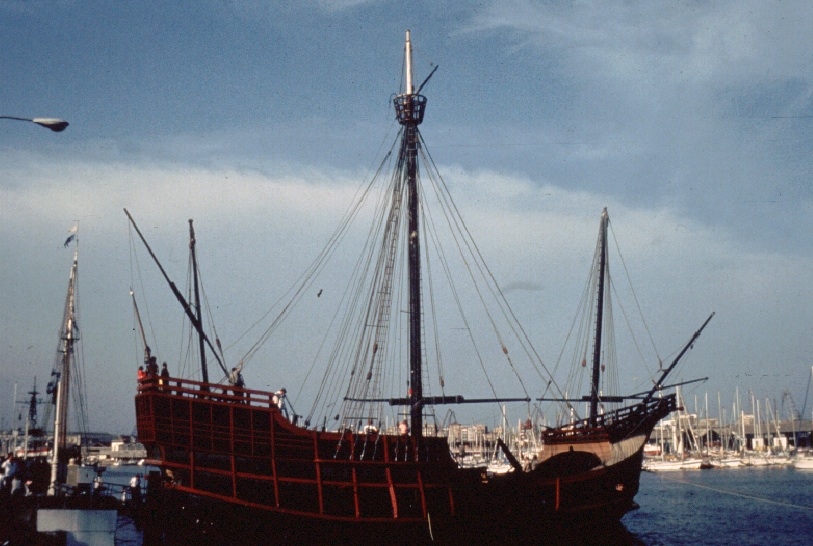
This is a full–size replica of the ship that Columbus sailed in 1492. It is small. You would run out of food and water on a trip of more than one month. So Columbus was taking a big risk to sail across the Ocean Sea.
[Fade off the ship image.]
The money for the voyage came from the Spanish treasury. During this period known as the Inquisition, the treasury had been enriched by property confiscated from Moslems and Jews who were expelled from Spain.

